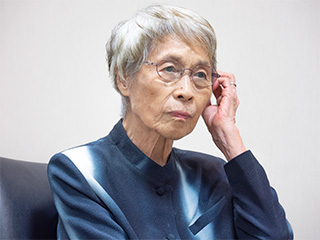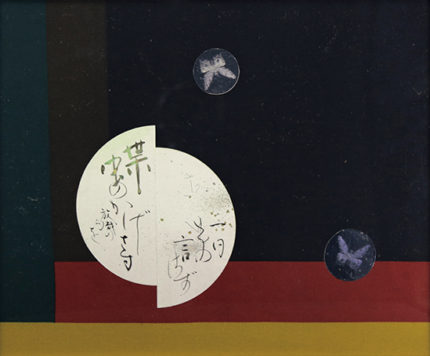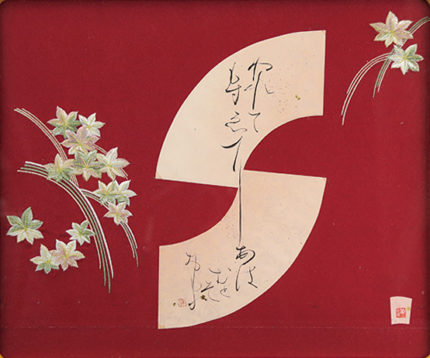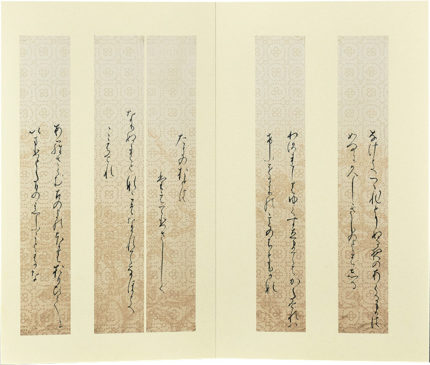- JEPAA Member

- Calligraphy
- Yoko Shimoyama
- 愛書家
- 下山洋子
© 2024 Yoko Shimoyama.
SCROLL
Portfolio /作品一覧
- 孤愁/solitude
- 思念/thought
- 小倉百人一首抄/Ogura Anthology of One Hundred Tanka
view more
Interview article /対談記事
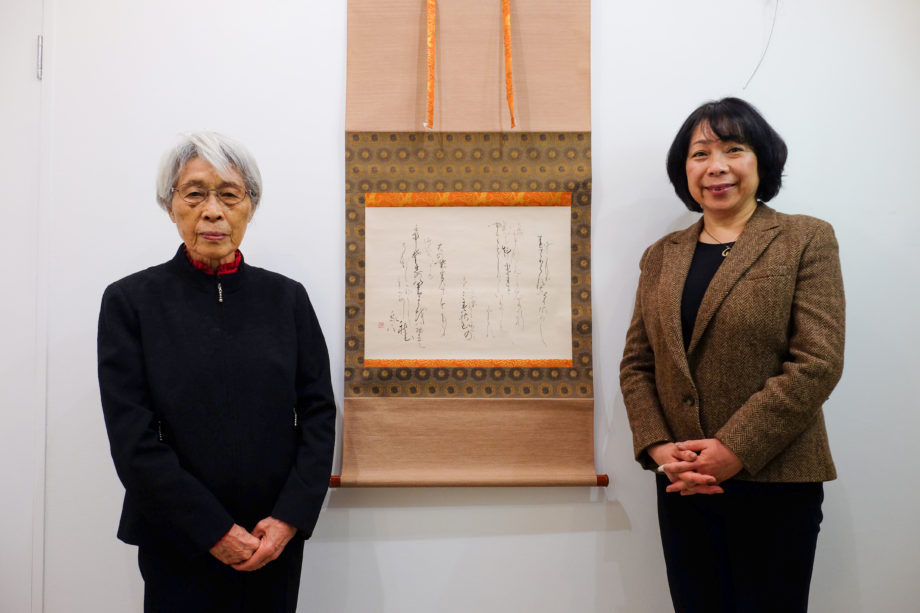
かなへのこだわり、師匠への敬愛が育んだ愛書の精神
ゲルマー・トモコ(以下 ゲルマー):本日はよろしくお願いします。下山先生にはドイツで素晴らしい書を出品していただき、現地でも多くの反響がありました。今日も素敵な作品を持参していただき、ありがとうございます。
下山洋子(以下 下山):これは、今自分の手元にある中で一番古い作品です。線もまだ洗練されていません。表装の仕方なども古いですね。かな書は表装との一体感が大事なので、書いている人間としてはかなり注意を払っています。古い作品を出すのは躊躇われるところもあったのですが、いつもと違う作品を見てもらうのもいいと思った。見て下さる方にも学びや気づきになってもらえると嬉しい。
今振り返ると、ドイツの方からお声がけ頂いたのは、私の書を通して師匠の教えが目に留まったからでもあるでしょうね。海外の展覧会に出品するという行為は、その“すごい人”から学んだ書を見てもらっているという観点もあると思います。師匠の教えについて行こうと必死で書いた作品は、それぞれが全然違う仕上がりになっています。海外の方には、それが作品ごとに変化があるように見えているのではないでしょうか。
ゲルマー:下山先生の作品ブースには、ベルリン大学の日本文学科の学生たちが大勢いました。彼らは1時間くらいもかけて真剣に見ていましたよ。とくにかな文字が好評だったようです。学生以外でも、専門的な知識のありそうな人がたくさんいました。かな文字は見る機会も少ないので、いっそう大きな反響があったのではないでしょうか。
実は去年のベルリンの展覧会は、直前までコロナ感染者の広がりが止まらず、開催は厳しい状況でした。ただ開催直前の6月になって奇跡的に感染者数が減ったんです。何か見えない力が働いたのかもしれません。そして、開催されると多くのドイツ人が来てくれて、感極まった顔で作品を鑑賞していました。あの時のみんなの顔は、今でも鮮明に覚えています。本当にみんな文化を渇望していたのだと強く感じました。
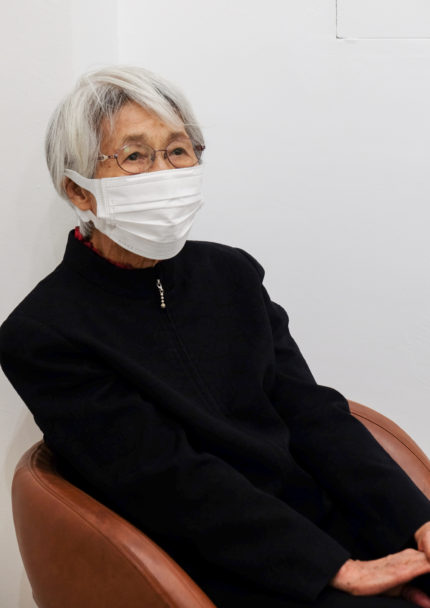
下山:そういった反応を聞くと、ドイツは良い国だなと思いますね。私自身もドイツの方に良い印象があって、イギリスの展覧会に出品した時の話なのですが、わざわざドイツの方が見にきてくれて、素晴らしい感想文を送ってくれたんですよ。涙が出るくらい嬉しかった。それから、ミュンヘンのニンフェンブルク宮殿で開かれた展覧会に自分も現地へ行きましたが、その時に子どもの見学ツアーも行われていましたね。みんな真剣に見てくれていました。おそらくドイツの人たちは、生まれ持って芸術の感性が備わっているのではないでしょうか。
ゲルマー:実は下山先生の作品を見ている方からは、たくさん質問されます。先生の書には、学びたい気持ちの強い人を引き寄せる魅力があるのではないでしょうか。私たちも、先生のかなへのこだわり、思いの強さは作品を通して感じています。多くの方に関心を深めてもらえるのはとてもありがたいことですが、私たちも答えられるよう準備をしておく必要があるので、会期中は身が引き締まる思いです。私も彼らの好奇心に応えたいので、ネットなどで調べていますが、かなり偏った情報が多いですね。もっと正しい回答、もっと深い知識があるのではないかと思いながら、日々情報を探しています。
最近の作品の中でとくに質問が多かったのは、小倉百人一首の作品ですね。「こんな遊びが現代まで残っていて実際に遊ばれているなんて、日本はなんと優雅な国か」とびっくりされました。今でも続けられるという文化性の高さは、ヨーロッパの人にとって驚きでしかないですね。
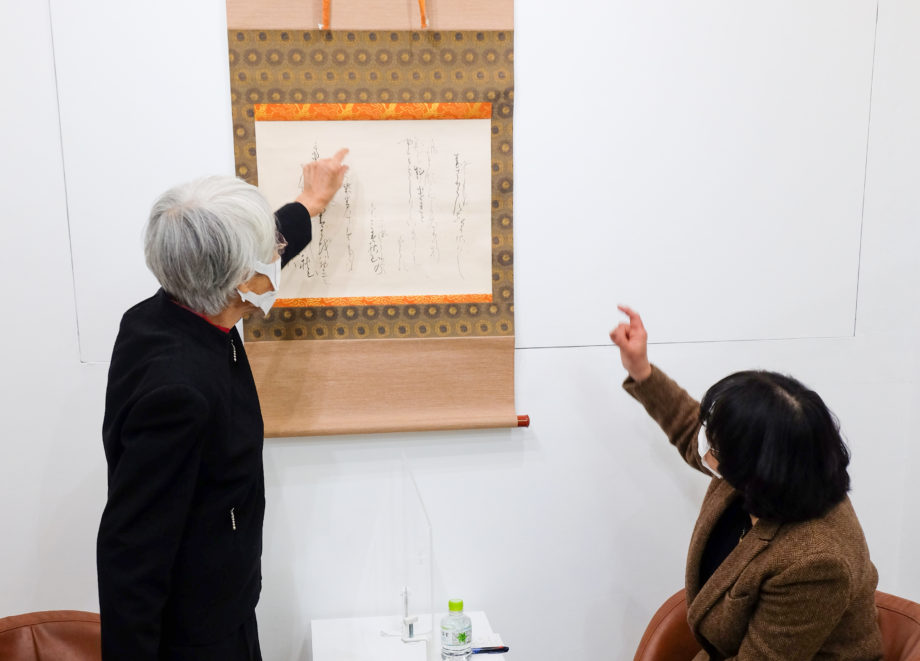
下山:コロナ禍では「世界に遅れる日本人」を嘆くことばかりでしたが、文化についてはまだまだ捨てたものではないと感じることがあります。日本人には、背中に文化を真剣に感じて生きているという一面があるんでしょう。
でも情報化社会の推進で日本人の文字文化、言語表現の力が弱まっていることに不安も感じています。若い人たちがインタビューで「楽しむ」とか「楽しんだ」という風に言うことがありますね。でも私には、そういう表現は使えません。真剣に自分をかけて取り組んでいる時、「楽しい」という気持ちになれるでしょうか? 私も作品を書き上げた時、なんとも言えない高揚感が胸に湧き上がった覚えはあります。ただ「楽しい」というようなものではなく、もっともっと複雑で特別な感情でした。なんで「楽しい」なんて簡単な言葉で例えてしまうのか。これは、日本人が何かを表現する語彙力が乏しくなっているからであり、日本文化が衰えている証拠のように思えます。
ゲルマー:私もそう思います。しかし下山先生は文字芸術のスペシャリストですから、私以上に憂慮する気持ちが強いのではないでしょうか。
下山:最近では教科書に載せている漢字や言葉の数も、政府の指示で減らされていると聞きます。国語教育も、それを指示する政治家もみんな悪いでしょう。でもその政府の指導に背いて漢字や単語を削除しなかった教科書が好評だったそうなので、まだまだ日本人の文化性も希望はあるように思いたいですね。
ゲルマー: そうですね、そして私たちもその文化と芸術を広く発信していきたいと思います。
下山:ゲルマーさんの思いにはとても感謝しています。私は本当に最初からかなを書こうという気持ちでやってきました。でも師匠から「根底に漢字のあるかな書の方が良い物になる」と言われていたので、漢字も勉強するようにしてきました。私はかなだけを書き続けていたかったのですが、漢字を勉強すべき理由を師匠からいくつも学んだことで、自分なりに納得はしていました。その理由の一つが、かな書への影響ですね。例えば、同じ書でもかなだけで書かずに漢字を織り交ぜた方が、完成した時に調和が生まれやすくなります。こういうものは、数えきれないぐらい練習を繰り返して体に染み込ませた上で、無意識に表現できるもの。だから、「根底にある」とか「奥深いもの」という師匠の物言いも、今ではなるほどと思います。今回持ってきた作品は、今になって見返してみると、確かに調和感で物足りません。まだまだ無意識に表現できていなかったということでしょうね。
ゲルマー:私たちからすると、その違いは言われてみてようやく気づける程度の差です。でもその僅かな差が、作品の完成度を高められるかを左右するんですね。
下山:師匠の教えに必死についてやってきたおかげで、どうにかそれを海外の方々にも伝えられるようになったんでしょう。
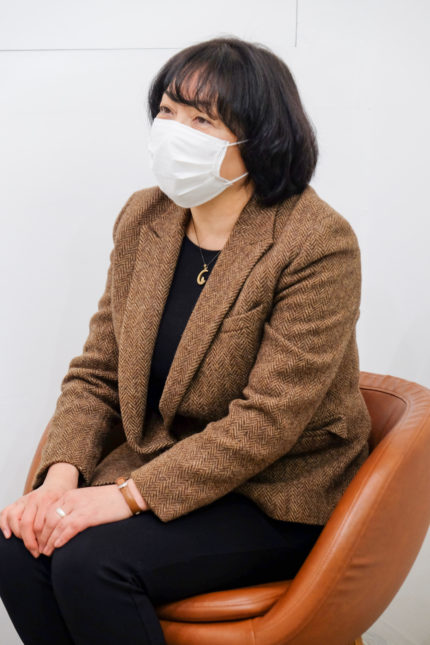
若い頃から書は大好きだったのですが、こういう難しさがあるからこそ、真剣にやらなきゃいけない世界だと、漠然と思っていました。自分が書を書く側に回ったのは50歳からですが、そういう覚悟が固まるのにそこまで時間がかかったからなんです。
ゲルマー:下山先生のお話を聞いていると、いつも覚悟のようなものを感じます。かな書の人気は先生のおかげで高まっていますから、ぜひより多くの学びを提供してほしいです。
下山:以前にドイツへ行った時は、書道を勉強している人と直に交流できていませんでした。より深い交流をするためにも、書を学びたい人々と現地で書について語ったり書を一緒に書いたりしたいですね。
ゲルマー:ぜひ実現していきましょう。シュミットさんやスチューデントさんからもよろしくと伝えられています。2人もドイツで先生とお会いできることを楽しみにしています。
下山:シュミットさんはとても気遣いのできる方です。お会いできたことに感謝しています。
ゲルマー:もっと自由に日本とドイツの行き来ができるようになったら、実現しましょう。今日はありがとうございました。
(2022年 下山洋子×ゲルマー・トモコ特別対談)
A spirit of love for calligraphy, nurtured by a commitment to kana script and respect for one’s master
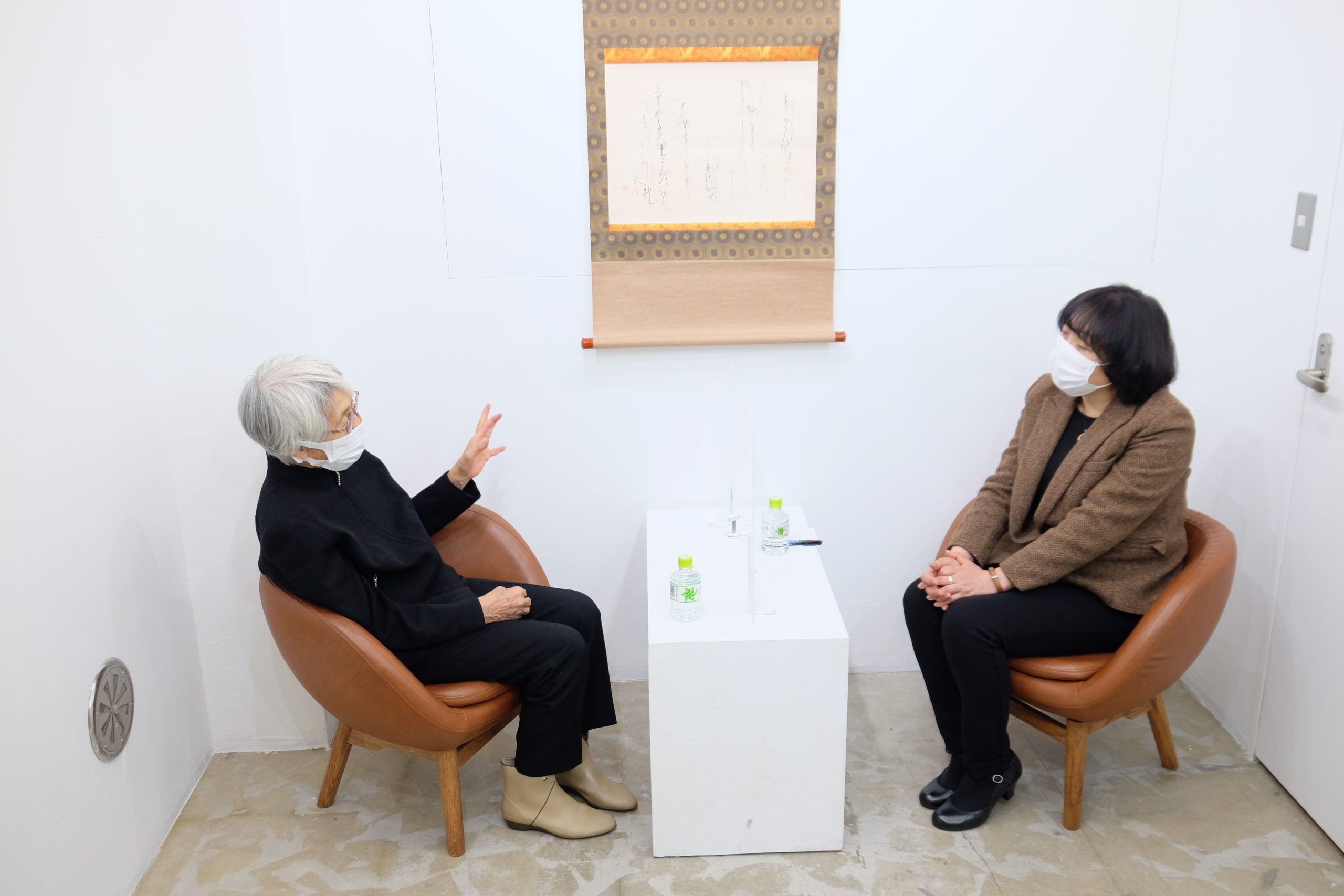
Tomoko Germar: Ms. Shimoyama, you exhibited your wonderful calligraphy in Germany and received a fantastic response there. Thank you very much for bringing your wonderful work here today as well.
Yoko Shimoyama: This is actually the oldest piece I have in my possession. My lines aren’t refined yet. The mounting style is also quite old. For kana calligraphy, I pay a lot of attention to the mounting because having a sense of unity with the mounting is important. I hesitated whether or not to show such an old piece, but I brought it in the hope that viewers might learn or realize something from it.It was an offer from a German exhibition that first led me to exhibit my work overseas. Looking back now, I suppose the reason I was approached by the German people was because my master’s teachings caught their eye through my calligraphy. Each of the works I created in frantic attempts to follow my master’s teachings ended up completely different. To people overseas, I think that is why each work seems to change from one to the next.
Germar: At the booth where your pieces were displayed, there were many students of Japanese literature from the University of Berlin and others who seemed to have specialized knowledge. Calligraphy in kana script is rarely seen, so I think the response was even greater. In fact, we often receive questions from people who have seen your work. I think your calligraphy has a certain fascination that attracts those who have a strong desire to learn. We, too, can sense the strength of your devotion and passion for kana script through your work. We are very grateful that so many people are seeking to deepen their interest.Of your recent works, we have received many questions especially about the Ogura Hyakunin Isshu, the historical anthology of 100 poems by 100 poets, often seen as a set of playing cards. They were surprised to hear that such a pastime has survived to the present day in Japan, and they remark on what a sophisticated country Japan must be. This high level of culture continuing to the present day is often a surprise to Europeans.
Shimoyama: During the COVID pandemic, all I heard were laments about“Japan lagging behind the rest of the world,”but I sometimes feel that, culturally, there is a lot we haven’t yet abandoned. I suppose there is an aspect to Japanese people that they live with a serious sense of carrying the culture on their backs. But I also feel uneasy about the weakening of the Japanese people’s written culture and ability to express themselves in language, due to advancement of the information society. Recently, I heard that the number of kanji characters and words in textbooks is being cut back at the instruction of the government. But I also heard that those textbooks that defied the government directive and refused to remove kanji or words were well received, so I’d like to think there is still hope for the cultural nature of the Japanese people.
Germar: Yes, and we also seek to disseminate that culture and art more widely.
Shimoyama: I really appreciate your thoughts on this matter. From the very beginning, I was trying to write in kana script. But my teacher told me that kana calligraphy taking kanji at its foundation would be better, so I decided to study kanji calligraphy as well. I wanted to continue calligraphy only in kana script, but from my master I learned a number of reasons why I should study kanji too, and in my own way I found them convincing. One of those reasons is kanji’s influence on kana calligraphy.For example, it is easier to create a sense of harmony in a completed piece of calligraphy if it is not written only in kana script but is rather interwoven with kanji. After countless hours of practice and becoming ingrained in the body, these things can be expressed unconsciously. That is why I now understand my teacher, who called such things“deep-seated”and “profound.”Looking back at this piece I’ve brought with me, I can see that I wasn’t yet able to express myself unconsciously.
Germar: From our point of view, the difference is so minor we can only notice it if someone tells us about it. But such a small difference can make or break the perfection of the work.
Shimoyama: It’s because I worked so hard to follow my master’s teachings that thankfully I’ve somehow been able to pass them on to people overseas. I’ve loved calligraphy since I was young, but I had the vague sense that precisely because it was so difficult, I needed to take it very seriously. I didn’t become a calligrapher until I was 50 years old. It took me that long to get ready to do that.
Germar: Whenever I hear you speak, I always feel that sense of determination. Thanks to you, the popularity of kana calligraphy is growing, and I hope you will offer learning opportunities to many more people.
Shimoyama: When I visited Germany previously, I wasn’t able to directly interact with people studying calligraphy. In order to have deeper interactions, I’d like to talk about calligraphy and create calligraphy together with people eager to study the art.
Germar: When we can travel more freely between Japan and Germany, let’s make that happen. Thank you very much for your time today.
(Special Talk in 2022 : Yoko Shimoyama & Tomoko Germer)

「時空を超えたかな書の美」
ハイケ・イェローミン(以下ハイケ):この度はお会いする機会をありがとうございます。早速ですが、書はいつ頃からやっておられるのですか?
下山洋子(以下下山):仕事が手から離れ始めた50歳の時からでね。もともと書は大好きだったのですが、社会人になってからは自分の仕事がありましたので、あえてやらないようにしていました。書をしっかりやろうとすれば、それに専念しなければ良い物はできないし、中途半端な向き合い方はしたくなかったのです。ですから、このように海外の方に作品を見ていただくことも、最初は不安なことばかりで、先のことなど全く見当がつきませんでした。
ハイケ:しかしそのおかげで、私はこうして下山先生の素敵な書を見ることができたわけです。ですから、その時に決断していただけたことを、本当に嬉しく思います。
下山:ありがとうございます。最近は国内の展覧会に出品することはありません。今は別の観点から書を学ぼうと、少しずつ実践しております。
ハイケ:お話を聞いていると、書に対する真摯さ、勤勉さが伝わってきます。それは、今回の作品の中にも通じているものがあると思うのですが、よろしければ制作の際のお話など伺ってよろしいですか?
下山:かな書は日本独自の書のスタイルで、この流麗な線と、優美な料紙の組み合わせは、回を重ねて書き込むほどに自ずと発揮するものです。到達点は無限の彼方です。
ハイケ:素晴らしいですね。自分自身の美意識が確立されているというのは、芸術家にとって非常に重要なことです。
下山:そうおっしゃっていただいて恐縮です。ハイケさんがウィーンからいらしてくださったということも一つの縁だなと思います。海外の展覧会に作品を出させていただく機会もこれまでに何度かありましたが、ウィーンは文字通り芸術の都ですし、2019 年春の日欧宮殿芸術祭でお誘いをいただいた時は本当に嬉しかったです。でも、展覧会には怪我で参加できず、本当に申し訳なく、心から残念に思いました。
ハイケ:先生がお怪我されたことはオーストリアの関係者も心配しておりましたが、こうして回復されていることがわかったので、本当によかったです。それに、作品の素晴らしさ、下山先生の力強く美しい書はウィーンにもしっかりと伝わりましたよ。
下山:ありがとうございます。自分自身は、遅いスタートでしたので、先輩方に少しでも近付くためには、優れた線を書く以外にはない、それには練習しかないと日々鍛錬し続けました。殊にかな書の一つの表現法として、華やかな料紙に調和した線の麗しさなどは言葉ではなく観賞者のそれぞれの美意識に訴えるものがあると思います。題材の「小倉百人一首」は諸説ありますが、京都の小倉山荘で歌人藤原定家が凡およそ数百年間の歌人から百人を選び一人一首ずつの和歌集です。その中から五十首選びました。現在でも「歌かるた」として人々に親しまれているのです。
ハイケ:本当に良いものは言葉を超えて伝わるのですね。そして、この後、展示に留まらずワークショップなど設けて、実体験をもとに、より広く深く、たくさんの人達に味わい伝えられれば、いっそう展望も拓かれますね。
こうしてこのように下山先生と私とが話すことで、よりお互いの理解が深まり、書の素晴らしさについてウィーンでお伝えすることができます。本日は本当に貴重なお話をありがとうございました。
(2019年特別対談 下山洋子×ハイケ・イェロミン)
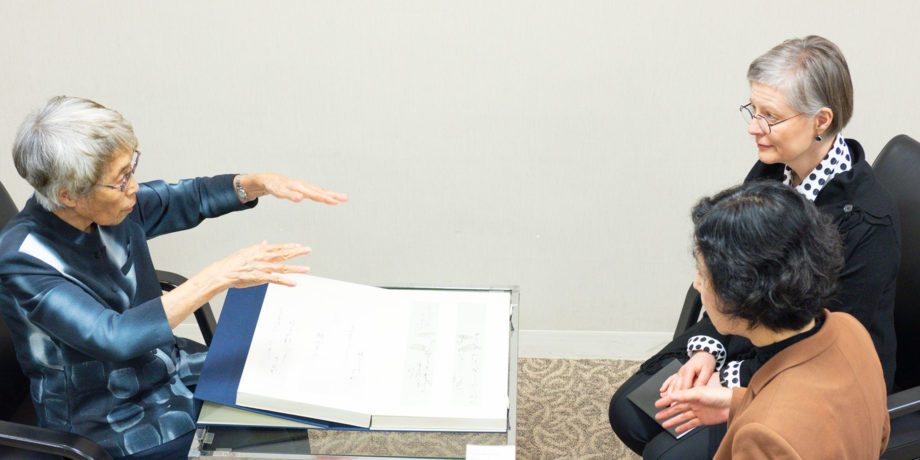
“The aesthetics of the magnificent kana calligraphy that resonates across the oceans”
Heike Jeromin (hereinafter referred to as“ Heike”):Thank you for allowing me to have this opportunity to meet you. I’ll start right away then. Please tell me when you started doing calligraphy?
Yoko Shimoyama (hereinafter referred to as “Shimoyama”): I began at the age of 50 when my career started slowing down. I’ve always loved calligraphy to begin with. But ever since I entered the workforce, I had to make a conscious decision to stop doing it because I had my own job to do. I also felt that I wasn’t going to be able to produce any good pieces unless I was serious about it and had given my undivided attention to it. I also didn’t really want to do the thing I loved half-heartily. That’s why I felt uneasy at first when I had to show my work to people overseas.
Heike: But it’s because of that, that I was able to see your wonderful work. So I’m really happy that you made the decision to do it at the time.
Shimoyama: Thank you. I haven’t really been showcasing any works at the recent domestic exhibitions. But I’ve been putting together the things I’ve studied so far.
Heike: By listening to you talk, I can really sense the sincerity and diligence that you have towards calligraphy. I think that these qualities will also be conveyed in some of your works this time. So would you mind telling me about how you came about creating these pieces?
Shimoyama: Kana is a style of calligraphy that’s unique to Japan. I feel that the combination between its flowing elegant strokes and the graceful writing paper really makes it beautiful.This is just my sense of aesthetics. And perhaps I’ll continue to create more kana calligraphy pieces for as long as I am able to hold a brush.
Heike: That’s great. It’s very important for artists to have their own established sense of aesthetics.
Shimoyama: I’m grateful to hear that from you. I also think that it was the work of fate for you to come here from Vienna. So far, I’ve gotten many opportunities to display my work in exhibitions overseas. I also thought that Vienna was the city of art. So when I received the invitation to go to the Spring 2019 Japan Europe Palace Art Festival, I was very happy. However, I wasn’t able to participate in the exhibition ceremony due to an injury. So I felt very sorry and disappointed about that.
Heike: The staff in Austria were also worried about your injury. But it’s really good to know that you’ve since recovered. On top of this, the magnificence of your work and your powerfully beautiful calligraphy pieces have also resonated soundly in Vienna.
Shimoyama: Thank you. Since I’m a late starter,I’ve been working hard with the hope of being able to present pieces of calligraphy that are in no way inferior to those of other calligraphers who are already active in the field. Thanks to that, I was able to feel that the charm of calligraphy has also been acknowledged overseas. I was especially moved by the fact that people were able to comprehensively understand the beauty of the strokes and the way in which they interacted with the writing paper. “Ogura Hyakunin Isshu” is a collection of poems by the singer Fujiwara Sadaie of Kokura Sanso in Kyoto, who has various theories, selected hundreds of excellent singers from
the past few hundred years and collected their representative works one by one. In this work, I chose 50 waka from here. By the way, “Ogura Hyakunin Isshu” is still popular as “Waka Poem karuta” by many Japanese.
Heike: Things that are really good can be expressed beyond words, can’t they? In the future, it is better to set up workshops as well as exhibitions. And if I can communicate the appeal of Japanese calligraphy to a wider and deeper audience based on real experiences,I think that the world of calligraphy will have even greater potential.
By talking like this, the two of us have deepened our understanding for one another.Additionally, I’m also now able to convey the brilliance of calligraphy in Vienna on your behalf. So thank you very much for having this valuable conversation with me today.
your behalf. So thank you very much for having this valuable conversation with me today.
(Special Talk in 2019 : Yoko Shimoyama and Heike Jeromin)
Art History /ヒストリー動画
Solo Exhibition /個展
特設個展ブースin 日欧宮殿芸術祭2021
会期:2021年6月4日~6日
会場:シャルロッテンブルク宮殿(ドイツ・ベルリン)
主催:一般社団法人 日欧宮殿芸術協会
運営:クリエイト・アイエムエス株式会社
Special Exhibition Booth in JEPAA Festival 2021
Dates: June 4-6, 2021
Venue: Charlottenburg Palace, Berlin, Germany
Organizer: Japan-Europe Palace Art Association
Operated by: Create IMS Co.
Profile /経歴
下山洋子 Yoko Shimoyama
1932年 東京都在住
師:桑田三舟
作品出展国遍歴(JEPAA関連事業):ドイツ、フランス、マルタ、カナダ他
Born: 1932 Tokyo, Japan
Master: Sanshu Kuwata
Exhibition of Works(JEPAA): Germany, France, Malta, Canada…

